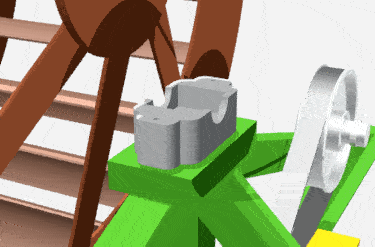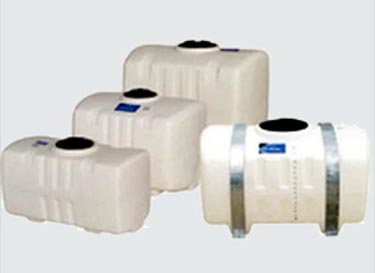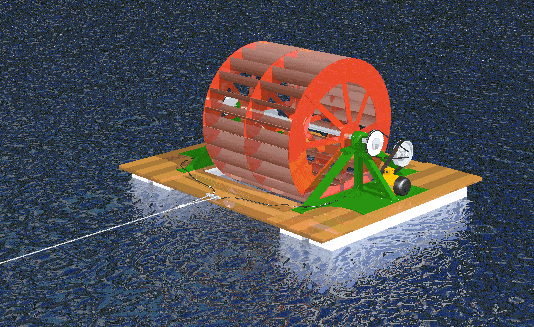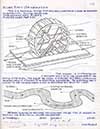Waterwheel Electrical Generator
Water Wheel Electrical Generator
This is a 2009 proposal by Steve Hines to use a water wheel floating on a river to generate clean electrical energy. Unlike solar and wind generators, rivers flow 24 hours a day.
The surface speed of rivers varies between about 3-7 MPH. Floating water wheels are typically 25-45% efficient. Pontoons can be made shaped like airfoils to increase the speed of the water between the pontoons under the wheel to increase the efficiency.
The water wheel turns at approximately 15-20 RPM. The water wheel can make use of a new style generator developed for small windmills that can operate as slow as 80 RPM. The required speed increase can be done first with a chain drive and then a belt-and-pulley system shown, or a gearbox.

Several floating water-wheel generators can be tied in series to multiply the electrical power generated.
 |
 |
|
Water-wheel assembly
The lower half of a sleeve is placed in the bottom of the split-bearing pillow block. The water wheel and shaft are lowered. The top of the pillow block is bolted down, then the sprocket wheels and chain drive are attached. The diameters of the sprocket wheels and pulleys are progressively smaller to increase the speed at the electrical generator. |
Flotation tanks Water tanks used for flotation and raising the wheel out of the water for maintenance.
Four 100-gal. water tanks, 81 x 26 x 11″ RecPro are shown, (supports 834 lbs. when empty). Sources: |
. A water wheel of this type can be cost effective in remote areas without access to power from a public utility. The 5-foot diameter water wheel shown can be scaled up or down.
The cost of a metal water wheel from Waterwheel Manufacturing in Franklin, North Carolina is approximately $5,000 for a 5-ft. wheel shown.
The approx. 2,585 lb. weight of the 5′-diameter waterwheel shown, made of 1/4-inch thick aluminum, can be supported on the four 100-gallon plastic water tanks, bellow the frame, filled with air. Ref.: water weights 8.345 lbs./gallon.
Comments:
• “I have seen your website which is very interesting!”, Emanuele Quaranta, hydraulics engineer, Polytechnic University of Turin Italy, June 1, 2017.
• “I’m… very impressed with the floating waterwheel that you posted online. I live next to the Concord River for about 20 years, flowing by with untapped clean energy. You came in mind after observing your ingenious floating waterwheel.“, Dominic Ndungu, Lowell, MA, March 11, 2016.
• “Simple and elegant!“, Val P., Houston, TX, January 7, 2016.
Clickable Resources:
- Water tanks for flotation, RecPro
- Water tanks for flotation, Home Depot.
- Water tanks for flotation, US Plastics.
- Water tanks for flotation, Chem-Tainer.
- Water wheel manufacturer: Waterwheel Manufacturing, Inc., Franklin, NC, USA
- Pontoons, available from: Nautilus Floats, Tiny Pontoons,
- 8,000-W electrical generator, Amazon.
- 12,000-W electrical generator. Amazon.
- Water wheel project: https://youtu.be/kh-8l8CdipM
- U.S. Geological Survey Agency, has data on the flow of rivers and streams in the United States.
- Scott Hydroelectricsells a small, efficient 1,500-Watt generator/water turbine, and control electronics that may be adaptable to this floating generator. Use a 3-phase AC high voltage alternator for long-line transmission. The 3-phase rectifier changes AC to DC for battery charging.
- Hardware supplier (sprockets, chain drives, pulleys, bolts, etc.): www.McMaster.com
- Waterwheel project in Africa in 2013, organized by Prof. Phil Thompson, Univ. of Seattle, Washington. The video states “The cost of this waterwheel is much less expensive than the equivalent energy from solar panels”.
- Waterwheel proposal in Australia, Feb. 2021: http://www.magpiepower.com
- How to rewire an old washing-machine motor to operate as a generator: http://youtu.be/NLaSf_YY7Xs
- Turn a ceiling fan into a wind turbine generator, https://youtu.be/ApKFeaJ6xYE
- Ceiling fan-to-generator conversion: http://youtu.be/4bZNoKKno48
- Emanuele Quaranta, PhD hydraulics engineer and water-wheel consultant.
Books
- ‘Water Wheels or Hydraulic Motors“, $23.95
- “A History of the Vertical Water Wheel“, $35.00
- “Principles of Construction and Efficiency of Water-wheels“, $24.95
- “Windmills and Waterwheels Explained“, $17.68
- “Hydropower“, $49.95
Hines’ original notebook entry:
This is not a product for sale.
HinesLab
USA
ph. 818-507-5812
email: Steve@HinesLab.com


